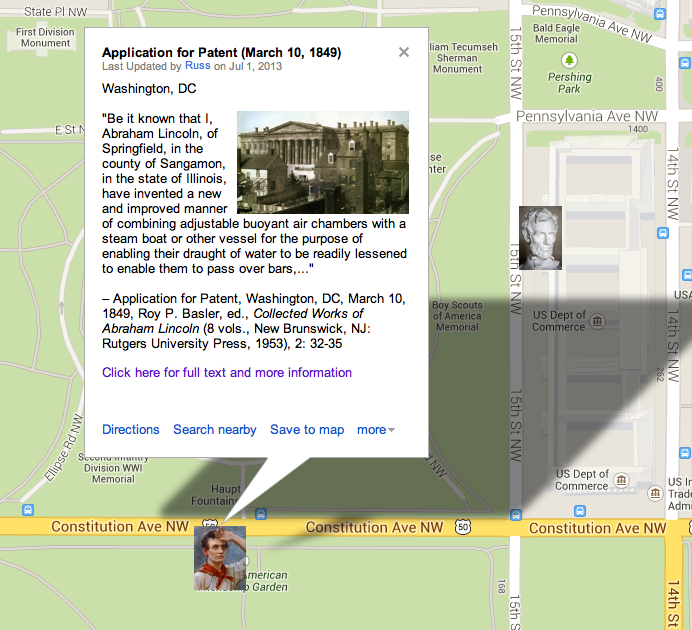Ranking
#122 on the list of 150 Most Teachable Lincoln Documents
Annotated Transcript
On This Date
HD Daily Report, March 10, 1849
The Lincoln Log, March 10, 1849
Custom Map
How Historians Interpret
“. . .Lincoln’s steamboat invention was utilitarian and not simply an exercise of his intellect or a self-aggrandizing means of fame and fortune (although if his model had been manufactured and he had realized some profit, he surely would not have complained or refused). Growing up as a pioneer farmer and boatman, Lincoln knew the necessity for reliable transportation not just for travel but also to take farm products to market, and he hoped his invention would help facilitate river navigation. It was the realization of Lincoln’s understanding of the needs of the western American as well as an outgrowth of his long-held political belief in internal improvements. Lincoln had championed Henry Clay’s American System since his first term as a state legislator in 1834 and continued it into his presidential terms.”
—Jason Emerson, Lincoln the Inventor (Carbondale: Southern Illinois University Press, 2009), 13
“By [November 1860], the outlines of [Lincoln’s] biography had grown familiar. But readers were surely surprised when the reigning bible of technology, Scientific American—otherwise devoting its latest issue to newly invented carriage wheels and gas meters—focused, too, on an eleven-year-old device for buoying vessels over river shoals. Neither the blueprint, nor the four-foot wooden model he had first floated in a Springfield trough more than eleven years earlier, had matured to the development phase, and in truth seemed unlikely to work. But the editors had learned that it had been invented ‘by no less a personage than the President elect of the United States.’ Abraham Lincoln’s 1849 patent (number 6469), though it had failed to attract investors, much less revolutionize river travel as once he had dreamed, now received the full Scientific American treatment, with the would-be inventor’s handmade wooden model exhaustively described and faithfully reproduced in woodcut. The journal tactfully sidestepped the scientific merits of Lincoln’s idea, gently conceding that ‘we hope the author of it will have better success in presiding as Chief Magistrate over the people of the entire Union than he has had as an inventor.’ But the magazine was clearly impressed, suggesting that Lincoln’s little-known foray into science demonstrated ‘the variety of talents possessed by men’—one man in particular. In face, no other president before or since has ever held a federal patent. As the magazine pointed out, ‘it is probable that among our readers there are thousands of mechanics who would devise a better apparatus for buoying steamboats over [sand]bars, but how many of them would be able to compete successfully in the race for the Presidency?'”
NOTE TO READERS
This page is under construction and will be developed further by students in the new “Understanding Lincoln” online course sponsored by the House Divided Project at Dickinson College and the Gilder Lehrman Institute of American History. To find out more about the course and to see some of our videotaped class sessions, including virtual field trips to Ford’s Theatre and Gettysburg, please visit our Livestream page at http://new.livestream.com/gilderlehrman/lincoln

